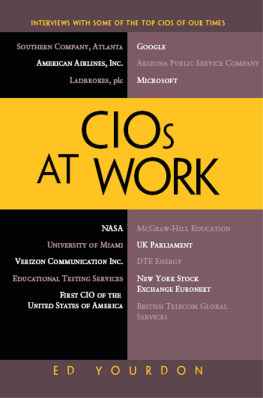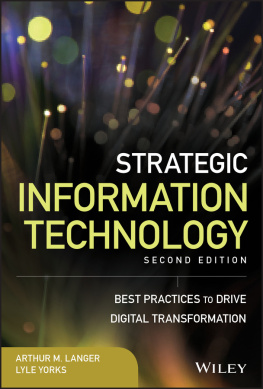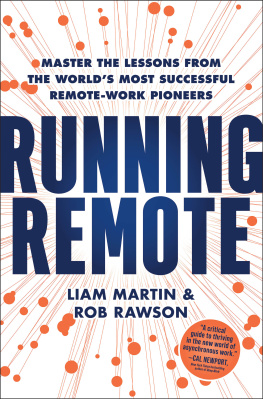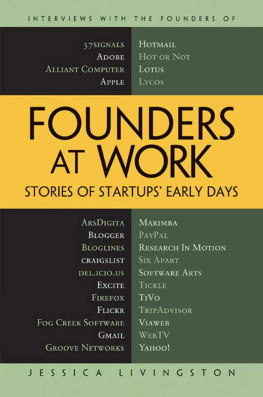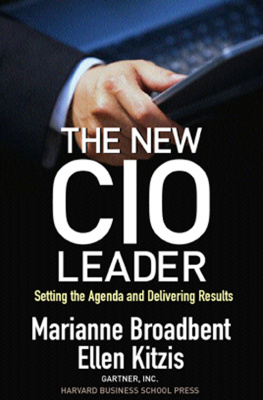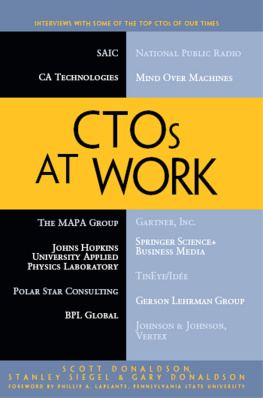CIOs at Work
Copyright 2011 by Ed Yourdon
All rights reserved. No part of this work may be reproduced or transmitted in any form or by any means, electronic or mechanical, including photocopying, recording, or by any information storage or retrieval system, without the prior written permission of the copyright owner and the publisher.
ISBN-13 (pbk): 978-1-4302-3554-5
ISBN-13 (electronic): 978-1-4302-3555-2
Trademarked names, logos, and images may appear in this book. Rather than use a trademark symbol with every occurrence of a trademarked name, logo, or image we use the names, logos, and images only in an editorial fashion and to the benefit of the trademark owner, with no intention of infringement of the trademark.
The use in this publication of trade names, trademarks, service marks, and similar terms, even if they are not identified as such, is not to be taken as an expression of opinion as to whether or not they are subject to proprietary rights.
President and Publisher: Paul Manning
Lead Editor: Jeffrey Pepper
Editorial Board: Steve Anglin, Mark Beckner, Ewan Buckingham, Gary Cornell,
Jonathan Gennick, Jonathan Hassell, Michelle Lowman, James Markham,
Matthew Moodie, Jeff Olson, Jeffrey Pepper, Frank Pohlmann, Douglas
Pundick, Ben Renow-Clarke, Dominic Shakeshaft, Matt Wade, Tom Welsh
Coordinating Editor: Jessica Belanger
Copy Editor: Kim Burton-Weisman
Proofreader: Nancy Sixsmith
Compositor: Mary Sudul
Indexer: BIM Indexing & Proofreading Services
Cover Designer: Anna Ishschenko
Distributed to the book trade worldwide by Springer Science+Business Media, LLC., 233 Spring Street, 6th Floor, New York, NY 10013. Phone 1-800-SPRINGER, fax 201-348-4505, e-mail orders-ny@springer-sbm.com, or visit http://www.springeronline.com.
For information on translations, please contact us by e-mail at info@apress.com, or visit www.apress.com.
Apress and friends of ED books may be purchased in bulk for academic, corporate, or promotional use. eBook versions and licenses are also available for most titles. For more information, reference our Special Bulk SaleseBook Licensing web page at www.apress.com/bulk-sales.
The information in this book is distributed on an as is basis, without warranty. Although every precaution has been taken in the preparation of this work, neither the author(s) nor Apress shall have any liability to any person or entity with respect to any loss or damage caused or alleged to be caused directly or indirectly by the information contained in this work.
To Teddy
Contents
About the Author
Ed Yourdon is a computer software consultant and IT expert witness in his own firm, NODRUOY Inc., as well as co-founder of the Cutter Consortium and Editor Emeritus of the Cutter IT Journal. Working in the software field for more than 45 years, he has published 27 computer-related books and more than 550 technical articles.
Yourdon has programmed, designed, and tested numerous software applications and programmer-productivity products. He has managed numerous projects as a first-level project leader and also as a senior IT executive. He has also reviewed numerous software development projects for clients during his consulting career.
Acknowledgments
It's hard to imagine anyone writing a book entirely on his or her owneven a novelist would be hard-pressed to deny the inspiration, support, encouragement, and feedback from friends, neighbors, a spouse, or a significant other. The same is true for textbooks and works of non-fiction; and it's definitely true of this book, CIOs at Work.
The most obvious people for me to acknowledge, of course, are the sixteen individuals whom I had the pleasure and honor of interviewing. Not only did they graciously carve a significant chunk of time out of their schedule in order to share their experience, their insights, and their advice, but they also shared their passion and excitement about the IT industry in which they work and to which they have dedicated a significant part of their professional lives.
Behind each of these CIOs there was at least oneand often two or threeadditional people that I need to acknowledge. First, the administrative assistants who help their bosses organize their schedules and coordinate their interactions with a wide range of people inside and outside their organization. For every e-mail interaction I had with a CIO, I probably had ten with his or her administrative assistant; and without their help, I would never have even reached the point of having a conversation with the CIO. They tend to stay in the background, but play a fairly invisible role; hence, I hope they'll forgive me if I don't mention their names.
There were also several people who helped me identify, locate, and contact the CIOs that I eventually interviewed. The most important of these was my editor, Jessica Belanger, who enthusiastically suggested industries that I had overlooked, companies whose CIOs were likely to be particularly interesting to interview, and clever strategies for tracking down CIOs who often seemed to be doing their level best to remain hidden from sight. Several people at Computer Aid, Inc. were quite helpful in my search for CIOs, including Mike Milutis, Joe Hessmiller, and James Nicol. I also got some much-needed help from Leon Kappelman, Toni Nash, and John Baker, as well as several quasi-anonymous people on Twitterand I am especially grateful for the assistance of @redmamba, who put me in touch with the CIO of Parliament in the United Kingdom. Indeed, the CIOs themselves were of great assistance, often introducing me to their fellow CIO colleagues, or at least telling me how to track them down and get in touch.
When it came to the actual writing of the book, there were three key people who kept me on track and helped keep me from going insane. Kristen Ng did an unbelievably professional (and fast!) job of transcribing the audio recording of each interview into an eminently readable and coherent word-processing document. My editor, Jessica Belanger, worked with me tirelessly to edit several audio conversations into readable English without losing the style, personality, and voice of the CIOs who spoke to me. And Apress' Assistant Publisher, Jeff Pepper, carefully reviewed each chapter and suggested additional questions that would help round out each conversation.
The only hesitation that an author has when it comes to acknowledgments is that he might have unconsciously overlooked someone when compiling the list. There is no doubt that I am guilty of such a sin, as I had numerous conversations and e-mail exchanges with friends, colleagues, and family members throughout the several months that I worked on CIOs at Work. Some of those whom I've inadvertently failed to mention won't even notice the oversight. Some will shrug and I suspect a few will mutter to themselves that I've deliberately slighted them. I apologize in advance to all those individuals and promise that I'll do a better job next time.
Ed Yourdon
Introduction
For the past two generations of human civilization, we have been told that we live in an Information Age. And for at least one generation, we have been told that our business organizations, our government agencies, and our day-to-day social lives depend more and more critically on computer technology. We no longer express any surprise about how rapidly technology is changing and evolving because it's something we all experience: every one of us has his or her own war story about how primitive things wereeven a short five years ago.

